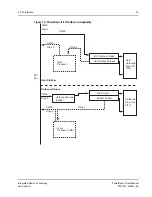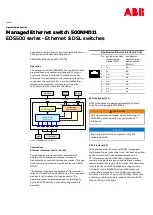
2. PCI Interface
61
PowerSpan II User Manual
80A1010_MA001_09
Integrated Device Technology
www.idt.com
During a read access, the VPD Address (VPDA) field and the VPD Flag (F) bit are written in the
“PCI-1 Vital Product Data Register” on page 267
. The F bit must be set to 0 to indicate a VPD read
access. PowerSpan II sets the F bit to 1 when it completes reading the 4 bytes from the EEPROM. The
F bit must be polled to determine when the read is complete. Byte 0 (bits 7 through 0) of the
Vital Product Data Register” on page 267
contains the data referenced by the VPD Address
—
bytes 1
through 3 contain the successive bytes.
2.5.3
Writing VPD Data
A write can only occur to the upper 128 bytes of the EEPROM or, potentially, the upper 192 bytes if
I
2
C chip select is non-zero. Similar to the read operation, the write operation always writes four
consecutive bytes starting from the VPD address to the EEPROM.
“PCI-1 Vital Product Data Register” on page 267
is written with the 4 bytes of data. Byte 0
(register bits 7 - 0) contains the data to be written to the location referenced by the VPD Address. Bytes
1-3 contain the data for the successive bytes. The VPDA field and the F bit is then written. The F bit
must be set to 1 to indicate a VPD write. The F bit is polled to determine when the write to the
EEPROM is completed. PowerSpan II sets the F bit to 0 when the write is completed.
When a write is attempted to the lower 64 bytes of the VPD area of the EEPROM, PowerSpan II does
not perform the write operation and clears the F bit.
If the Px_VPDD register or the I2C_CSR register is written to prior to the flag bit being set to
1, the results of the original read operation are unpredictable.
The Px_VPDD or I2C_CSR register must not be written while a write operation is occurring.
















































